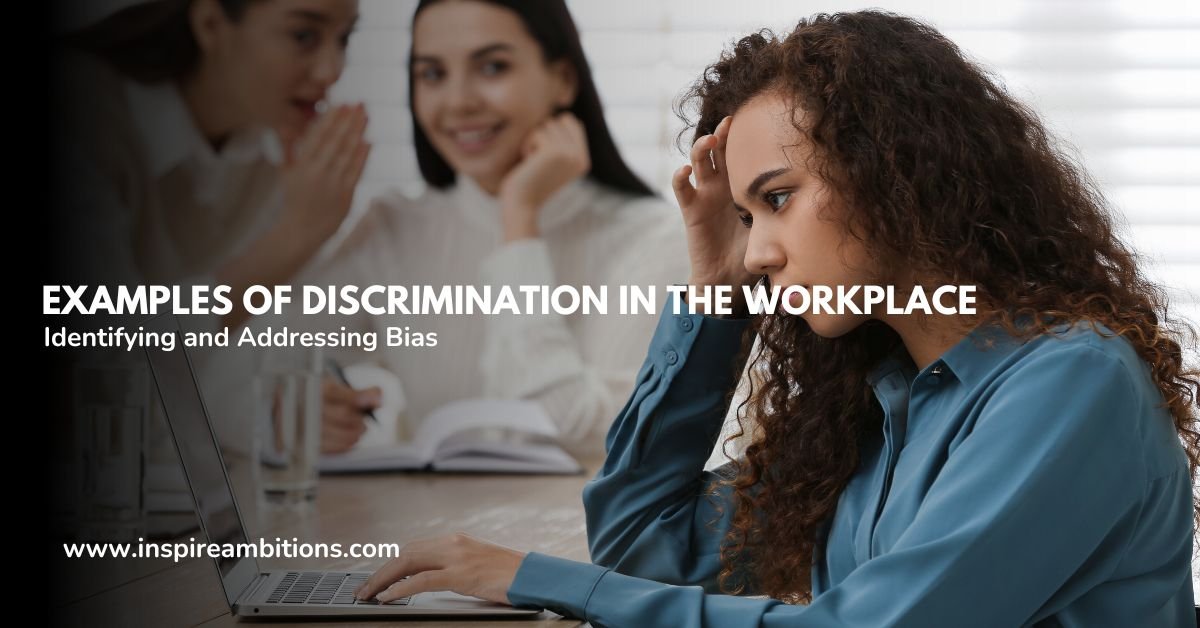أمثلة على التمييز في مكان العمل - تحديد التحيز ومعالجته
Discrimination in the workplace remains a pressing concern despite numerous laws and measures designed to eradicate it. Under the Civil Rights Act of 1964, employees are protected from discrimination based on race, colour, religion, sex, national origin, age, disability, or genetic information.
It’s crucial to understand that workplace discrimination can manifest in various aspects of employment, including recruitment, hiring, promotions, and day-to-day interactions.

As an employee or employer, it’s essential to recognize all forms of overt or subtle discrimination to foster an inclusive work environment. The Equal Employment Opportunity Commission (EEOC) enforces federal laws about action against a job applicant or an employee. Being aware of your rights and responsibilities is the first step towards preventing discrimination and addressing it effectively if it occurs.
Examples of Discrimination in the Workplace – Key Takeaways
- Workplace discrimination can occur in various employment aspects and is prohibited by law.
- The Civil Rights Act of 1964 and the EEOC protect employees’ rights.
- Awareness and understanding of rights and responsibilities are vital to combating workplace discrimination.
Types of Discrimination and Legal Framework

Workplace discrimination encompasses various forms of unequal treatment that are legally protected against. Below, you’ll uncover the specific categories of discrimination and the laws designed to prevent them.
Racial and Color Discrimination
Racial [discrimination](https://www.eeoc.gov/discrimination-type) targets individuals based on race or ethnicity. Title VII of the Civil Rights Act of 1964 prohibits employers from discriminating against employees based on race, colour, religion, sex, or national origin. Colour discrimination involves treating someone unfavourably because of skin colour complexion.
Gender and Sexual Orientation Discrimination
Gender discrimination occurs when an employee is treated differently because of their gender identity or sexual orientation. Title VII is also pertinent here and has been interpreted to protect LGBT employees. Sexual orientation discrimination includes any bias against someone because of their actual or perceived sexual orientation.
Age Discrimination and Disability Discrimination
The Age Discrimination in Employment Act (ADEA) protects employees 40 or older from workplace discrimination. Meanwhile, the Americans with Disabilities Act (ADA) ensures that people with disabilities are not discriminated against in the workplace. Disability discrimination can manifest through the refusal to provide reasonable accommodations.
Religious and National Origin Discrimination
Religious discrimination involves treating a person unfavourably due to their religious beliefs. National origin discrimination is unfair treatment because of a person’s ancestry, culture, accent, or country of origin. Both types of discrimination are also covered under Title VII of the Civil Rights Act.
Pregnancy Discrimination and Genetic Information Discrimination
The Pregnancy Discrimination Act (PDA) forbids discrimination based on pregnancy when it comes to any aspect of employment. It is considered an integral part of Title VII. The Equal Pay Act requires that men and women in the same workplace be given equal pay for equal work. The Genetic Information Nondiscrimination Act (GINA) also prohibits genetic information discrimination in employment.
These federal laws serve as a cornerstone for creating a fair and equitable work environment, armed with the legal framework to confront discriminatory practices. To ensure an inclusive workplace, you must be aware of these rights and protection in recruitment, Hiring, and Promotion.

“Justice in the workplace begins at the hiring sign.” The sentiment is clear: equality must be the cornerstone of all workplace processes, especially recruitment, hiring, and promotion. These stages are vital to job applicants and employers, significantly influencing a company’s culture and diversity.
Discriminatory Hiring Practices
When you apply for a job, the expectation is that your skills and qualifications will be the only factors considered. However, discriminatory hiring practices often overshadow merit. This can range from excluding specific candidates based on personal characteristics to posing biased interview questions that may favour one group over another. For instance:
- Candidates might be judged by their name أو area rather than their abilities.
- ال language used in job descriptions can unintentionally deter women and minorities from applying.
One must be vigilant for signs of discrimination and support initiatives that foster a fair hiring process. For insights on effectively preventing discrimination in hiring, refer to Hiring discrimination – examples and how to avoid it.
Unfair Promotion and Advancement Barriers
Once part of an organization, you’d expect to progress based on your performance and commitment. Yet, promotion practices are often clouded by favouritism or unconscious bias, building invisible barriers that stifle التقدم الوظيفي. Discrimination in promotion can manifest as:
- Overlooking qualified candidates for promotion due to subconscious stereotypes or personal biases.
- Lacking transparency in the criteria used to assess eligibility for advancement.
To confront these challenges, become familiar with Prohibited Employment Policies/Practices and demand clarity in your organization’s promotion policy to mitigate unfair advancement barriers.
By understanding and advocating against discriminatory practices, you can help transform the landscape of your workplace, ensuring a fair and just opportunity for all to excel.
5 Key Policies to Address Workplace Microaggressions
Dress codes and job responsibilities are pivotal aspects of workplace policies that can inadvertently perpetrate microaggressions. At the same time, unconscious bias in these areas can profoundly affect employees, especially those from marginalized groups. Effective strategies and training opportunities are essential to mitigate these issues and foster an inclusive work environment.
Dress Codes and Job Responsibilities
Dress Codes:
- Expectations: Dress codes often reflect the company’s culture and the nature of the job. However, they can also perpetuate stereotypes and discrimination, subtly implying that certain appearances are more professional, often to the detriment of cultural attire and diversity.
- Implications: Strict or culturally insensitive dress codes may make employees feel excluded or penalized for their natural appearance, which could relate to their ethnicity, gender, religion, or cultural background.
Job Responsibilities:
- Distribution: Equitable distribution of job responsibilities ensures all employees have equal access to career advancement and professional development.
- Bias: Unconscious biases may influence task delegation, potentially leading to marginalized groups receiving fewer opportunities or being overlooked for career-advancing projects.
Microaggressions and Subtle Biases
Microaggressions:
- أمثلة: Microaggressions can range from backhanded compliments to exclusionary jokes or dismissive behaviours that send derogatory messages to targeted individuals or groups.
- Training Opportunities: Implementing diversity training and raising awareness about microaggressions helps create a more supportive environment. Companies can educate their workforce on recognizing and countering subtle biases.
Unconscious Bias:
- Recognition: Encouraging employees to recognize their unconscious biases is a crucial step towards reducing their impact within the workplace.
- Strategies: Structured processes and objective criteria in evaluations, promotions, and hiring can help minimize the influence of unconscious bias and promote fairness.
Addressing Discrimination
Discrimination in the workplace can manifest in various forms, including unequal pay, refusal of reasonable accommodations, or retaliation against employees taking maternity leave. Knowing how to address such issues is crucial for employees and employers alike.
Filing Discrimination Charges and Lawsuits
If you face discrimination at work, it’s your right to file discrimination charges with appropriate government agencies. The process usually begins with an investigation by entities such as the Equal Employment Opportunity Commission (EEOC). Filing within the required timeframe is essential, as waiting too long might forfeit your right to pursue a claim.
Lawsuits can be a subsequent step if the agency’s resolution is unsatisfactory or they grant a “Right to Sue” letter. Legal action requires thorough documentation of the discriminatory acts and often involves securing a lawyer experienced in employment law. Courts can order remedies that may include compensation for lost wages, reinstatement, or changes in workplace policies.
Creating an Inclusive Workplace
Formulating and sustaining an inclusive workplace goes a long way in mitigating discrimination. Employers should train their management and staff on diversity and inclusion to foster an environment of mutual respect.
- Reasonable accommodations should be provided for employees’ varied needs, ensuring that all staff can perform their jobs effectively.
- Companies should regularly audit their policies and practices to guarantee equal pay for equal work, regardless of gender, ethnicity, or other characteristics.
- Employers must support employees on maternity leave, ensuring their roles are protected and their return to work is well-handled.
- Anti-retaliation policies must be clear and enforced to protect those who report discrimination or participate in تمرين programs to reduce workplace bias.
By educating your workforce and implementing equitable policies, you comply with the law and contribute to a more productive and loyal workforce.
Consequences and Prevention
Regarding workplace discrimination, the stakes are high for both employees and employers. Understanding the dire consequences and the practical measures for prevention is the key to fostering a fair and safe work environment.
Punishments for Discriminatory Practices
Discriminatory practices in the workplace are not only unethical, but they are also غير قانوني. Federal and state laws prohibit discrimination, and violations can lead to significant punishment. This may include نهاية of the offending party’s employment or severe الغرامات imposed on the company. Furthermore, victims of discrimination can seek legal redress, which can result in companies facing costly litigation, potential demotion of their public image, and financial liabilities.
Federal laws, such as Title VII of the Civil Rights Act, the Americans with Disabilities Act (ADA), and the Age Discrimination in Employment Act (ADEA), lay down clear regulations against workplace discrimination. Additionally, states may have their laws with varying degrees of protection. Termination أو firing of an employee based on discriminatory reasons can be grounds for a lawsuit, where employers might face both compensatory and punitive damages.
Training and Awareness Programs
فعال تمرين programs and heightened awareness are critical components in preventing discrimination. Employers are encouraged to conduct regular تمرين sessions to educate employees about anti-discrimination laws and company policies. These programs should precisely aim to shed light on what constitutes discrimination and harassment, emphasizing the importance of respect and diversity in the workplace.
Both managers and staff benefit from such programs, as they help create a more inclusive atmosphere. Through these حصص التدريب, individuals learn the correct procedures for reporting discrimination, and management staff are better prepared to handle such complaints decisively. An educated workforce is the first step towards eliminating discrimination and fostering a culture where all employees are valued for their skills and contributions.







